Warship Wednesday, April 24, 2024: A Flower So Nice They Painted Her Thrice
Here at LSOZI, we take off every Wednesday for a look at the old steam/diesel navies of the 1833-1954 period and will profile a different ship each week. These ships have a life, a tale all their own, which sometimes takes them to the strangest places.- Christopher Eger
Warship Wednesday, April 24, 2024: A Flower So Nice They Painted Her Thrice
Above we see a detailed image of the plucky little Flower-class corvette HMCS Snowberry (K166) of the Royal Canadian Navy underway during World War II. She is pictured in the above just after she left Charleston Navy Yard in South Carolina following a much-needed refit that saw her both refreshed and her fo’c’s’le extended to provide better handling of the stubby 925-ton escort while on North Atlantic convoy runs, her staple employment for the duration of the war.
The Flowers
A handy little sub-buster that could be cranked out in record time but was still very capable of escorting slow-moving merchantmen from the Americas to Europe during the Battle of the Atlantic, the Admiralty would order more than 300 Gladiolus/Flower-class corvettes from 1939 onward.
Essentially a stretched version of the Smith’s Dock’s 582 GRT, 160-foot steam-powered whaler design built in 1936 for the Southern Whaling & Sealing Co. Ltd (SWSC), they were single-screw vessels powered by a pair of cylindrical Scotch marine boilers feeding a single VTE engine that could, when turning at maximum RPMs, generate a theoretical 2,750 h.p., enough to push the little tub 16 ish knots while an economical load of 230 tons of fuel oil would get them 3,500nm at 12 knots, enough to make it across the Atlantic on the 2,700-mile Halifax to Liverpool route with some fuel left for maneuvering.
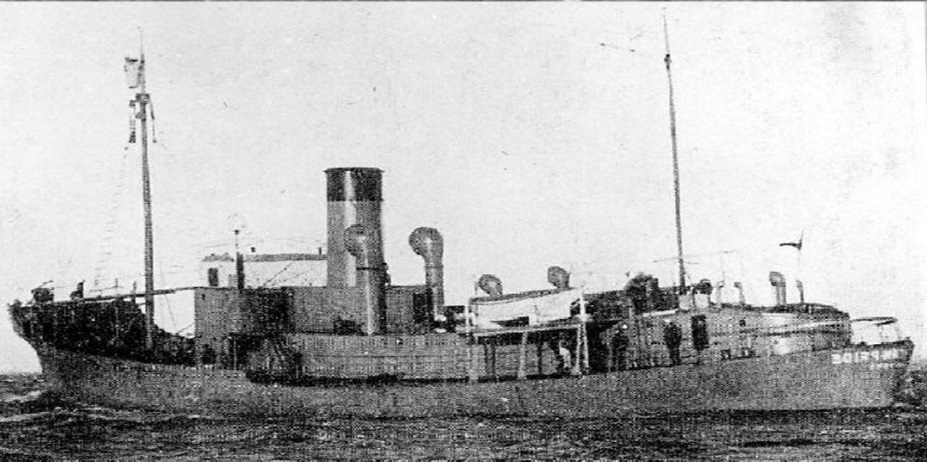
The Flowers were based on the SWSC’s Southern Pride, shown here in her pre-war whaler service. The vessel would be requisitioned by the RN (K 249) in 1940 and lost in 1944 off Freetown.
Using the simpler boiler pattern and including enough space for a crew of 80 officers and men (later to swell to as much as 110), the dimensions shifted from a 160-foot whaler to a 205-foot corvette. With a correspondingly wide 33-foot beam, they had a stubby 1:6 length-beam ratio.
Armament was slight: a single 4″/45 BL Mk IX forward, a 40mm/39 2pdr QF Mk VIII pom-pom on a “bandstand” platform aft, a couple of depth charge throwers and two depth charge racks over the stern, with provision for up to 40 ash cans. They also had a perfectly adequate Type 123 or Type 128 sonar and (eventually) a Type 271 or Type 286 radar. Of course, there were extensive modifications to this and tweaks across the massive production line, but you get the idea. Late war fits included as many as 70 depth charges, a Hedgehog ASW device, and a half-dozen 20mm Oerlikons.
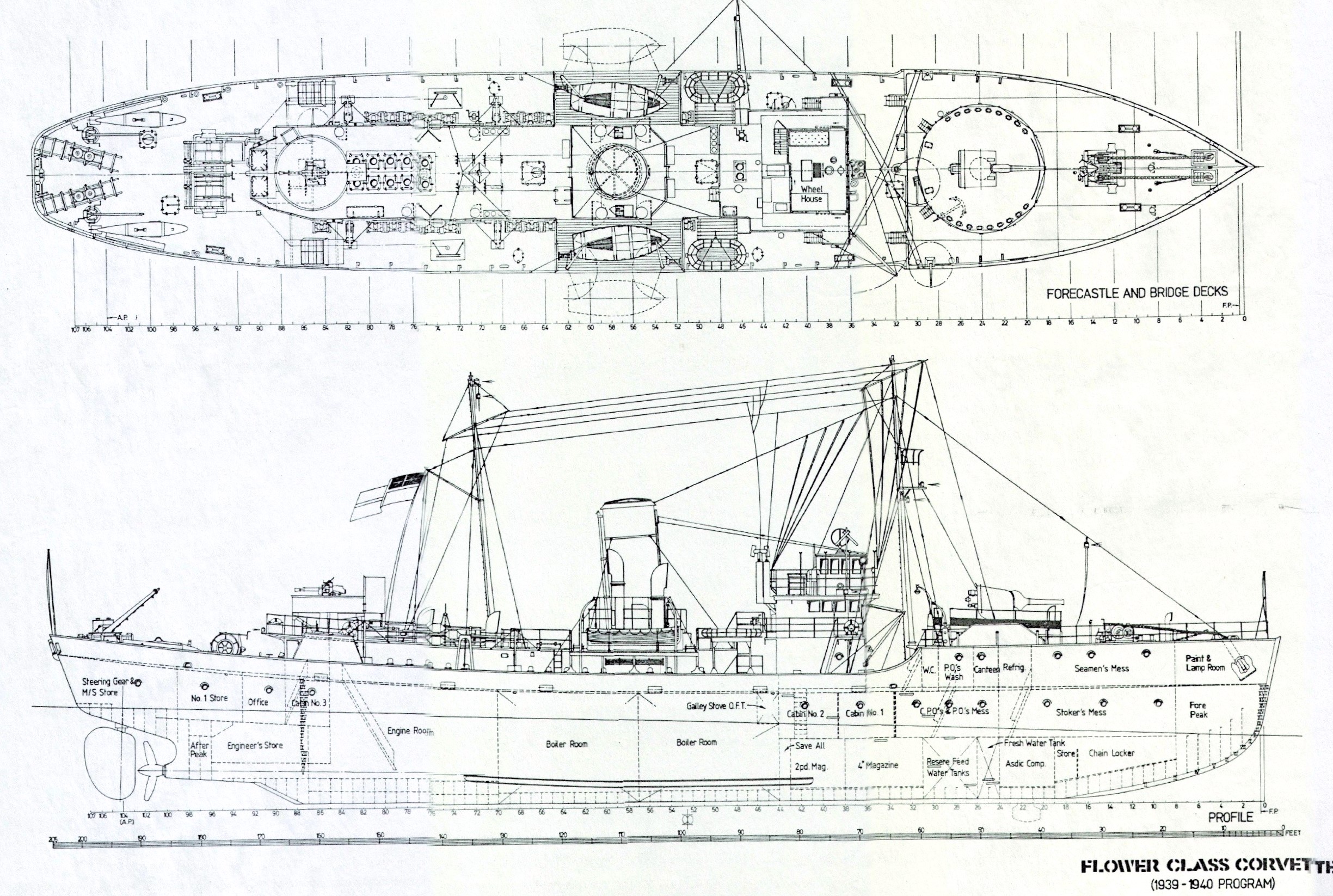
Drawing of a Flower Class Corvette showing the ship’s layout by John W. McKay – 1992. Source: “Corvettes of the Royal Canadian Navy 1939-1945” by Ken MacPherson and Marc Milner
Built to merchant (Lloyds) standards rather than to those of the Admiralty, they could be churned out rapidly at about any small coastwise commercial shipyard and several dozen shipyards participated in the program in the UK and Canada. Some 13 Canadian yards alone (Burrard, Canadian Vickers, Collingwood, Davie & Sons, Davie SB, Kingston SB, Marine Industries, Midland SY, Morton Eng. & D.D. Co, Port Arthur SB, Victoria Machinery, and Yarrows Esquimalt) made a whopping 122 Flowers during the conflict.
The average construction time was 6-8 months, a process often sped up by the fact that the armament and sensors would be installed post-delivery at a nearby naval yard, sometimes in stages, a problem that meant some Flowers had to deploy for months before they received all their gear.
No less than 111 Flowers were assigned to the RCN at one point or another, of which 7 were canceled while still under construction, 80 were built from the start for the Canadians, and 24 RN corvettes (many of which were built in Canadian yards) transferred on loan.
Meet Snowberry
Our subject, laid down for the Royal Navy on 24 February 1940 at Davie Shipbuilding (now Chantier Davie Canada Inc. but still in business) at Lauzon, Quebec, was named, in line with the convention used for the rest of the Flowers, after Symphoricarpos albus-– the common snowberry. Launched just six months later, she was delivered to the RN and commissioned at Quebec City on 26 November 1940, the gestation period of HMS Snowberry (K166) lasted but eight months.
War Baby
Manned by a Canadian crew led by LT Roy Stanley Kelly, RCNR, Snowberry sailed for Halifax to pick up her armament and then, after crossing the Atlantic with her first convoy (HX.108) she finished her fitting out process at Greenock, Scotland. Following a stint with Western Approaches Command, she was loaned to the Royal Canadian Navy and commissioned as HMCS Snowberry on 15 May 1941 with the same pennant number. In June 1941, she sailed for Newfoundland and would get to arduous work there in convoy service.
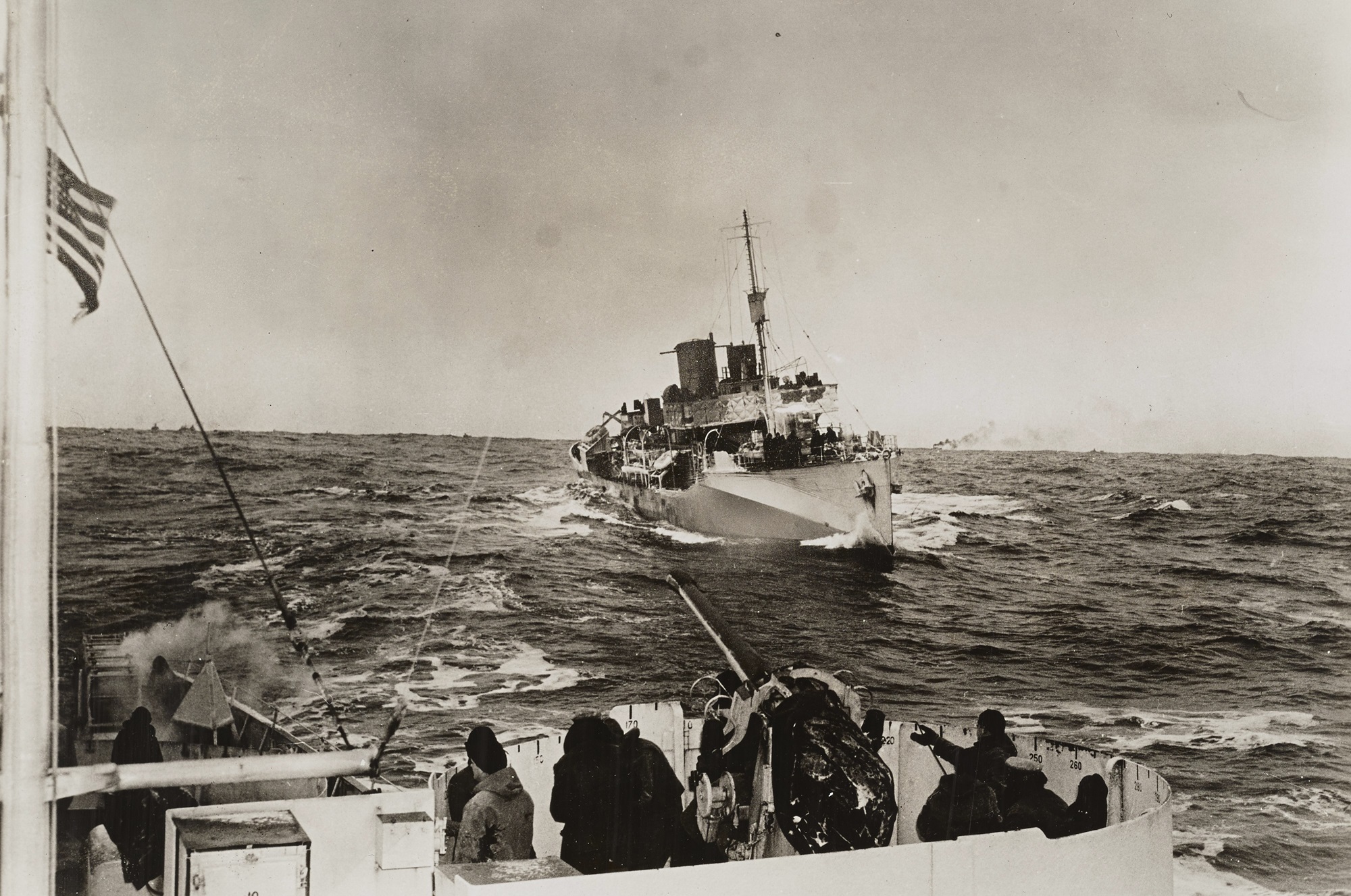
This image depicts a Canadian corvette as it comes alongside a U.S. Coast Guard cutter in April 1943
In all, Snowberry took part in an impressive 74 convoys between 3 February 1941 (HX.108) and 15 April 1945, broken down into 15 in 1941, 19 in the hellish year that was 1942, 16 in 1943, just 11 in 1944, and a baker’s dozen in just the first four months of 1945.
Most of these (29) were dangerous HX or ON convoys from New York/Halifax to Liverpool and vice-versa but she did manage to venture into the Caribbean every now and then on TAW, GN, and AH convoys.
Her two most notable brushes with the Jerries included the sinking of the brand-new Type IXC/40 U-536 (Kptlt. Rolf Schauenburg), on 20 November 1943 in the North Atlantic northeast of the Azores in conjunction with her Canadian Flower sister HMCS Calgary (K231) and the British River-class frigate, HMS Nene.
Schauenburg, on only his second war patrol of 2. Flottille out of Lorient, survived along with 16 of his men to become POWs.
From the official report of the sinking of U-536.


1943 Devonport Dockyard, Nov 25, 1943, U-536 survivors brought in by crews of HMCS Snowberry, HMS Tweed, and HMCS Calgary. Note the Lanchester SMG

LOSERS IN THE ATLANTIC BATTLE. 25 NOVEMBER 1943, PLYMOUTH, DEVONPORT DOCKYARD. MORE U-BOAT PRISONERS; 17 OFFICERS AND MEN BEING LANDED BLINDFOLDED IN THE SOUTH-WEST PORT FROM A CONVOY ESCORT SHIP WHICH PICKED THEM UP AFTER THEIR SUBMARINE HAD BEEN SUNK. (A 20600) U-Boat prisoners arriving at Devonport blindfolded. Copyright: © IWM. Original Source: http://www.iwm.org.uk/collections/item/object/205153048
The second notable incident with the Germans was in the first use of glider bombs against Allied shipping, deployed by the famous II.Gruppe/KG 100.
As detailed by Uboat.net:
On the 25th of August 1943, the Canadian 5th Support Group (Cdr. Tweed), consisting of the British frigates HMS Nene, HMS Tweed, and the Canadian corvettes HMCS Calgary, HMCS Edmundston and HMCS Snowberry were deployed to relieve the 40th Escort Group. While this was in progress the ships were attacked at 1415 hrs by 14 Dornier Do-217s and 7 Ju-88s. with the new German weapon, the Henschel radio-guided glide bomb, (the “Hs293 A-1”) designed by the German Professor Herbert Wagner. The sloops HMS Landguard and HMS Bideford of the 40th Escort Group were the first of the Allied and R.N. ships to be attacked and damaged by them. This was the first time their being brought into action against Allied ships. Several sailors were injured on HMS Bideford and one sailor was killed, the light damage as the 650-pound warhead did not detonate.
Snowberry finished the war with the Portsmouth Command and was handed back to the RN at Rosyth on 8 Jun 1945.
However, the Brits were not keen to keep any of these converted whalers around and quickly disposed of them wholesale. Ex-Snowberry was sunk as a target vessel off Portsmouth in 1946, then her hulk was raised by a salvage company and broken up at Thornaby-on-Tees in 1947.
During WWII, Canadian vessels escorted over 181 million tons of cargo across the pond, sinking 27 German U-boats in the process (14 of which were bagged by RCN corvettes) as well as accounting for a further 42 Axis surface ships.
In return, the Canadians lost 24 ships of their own during the war, along with 1,800 men with hearts of steel. Of those 24 vessels, 10 were Flower class corvettes including HMCS Alberni, sunk by U-480; HMCS Charlottetown, sunk by U-517; HMCS Levis, sent to the bottom by German torpedoes in 1941; HMCS Louisburg, sunk by Italian aircraft off Oran; HMCS Shawinigan, sunk by U-1228; HMCS Trentonian, sunk by U-1004; along with HMCS Regina and HMCS Weyburn, lost to mines.
Epilogue
A crew site has been established for the diligent little corvette through the For Posterity Sake initiative.
Snowberry has been immortalized at least three times since the 1970s. The first was by renowned British maritime artist John Hamilton now in the collection of the Imperial War Museum.
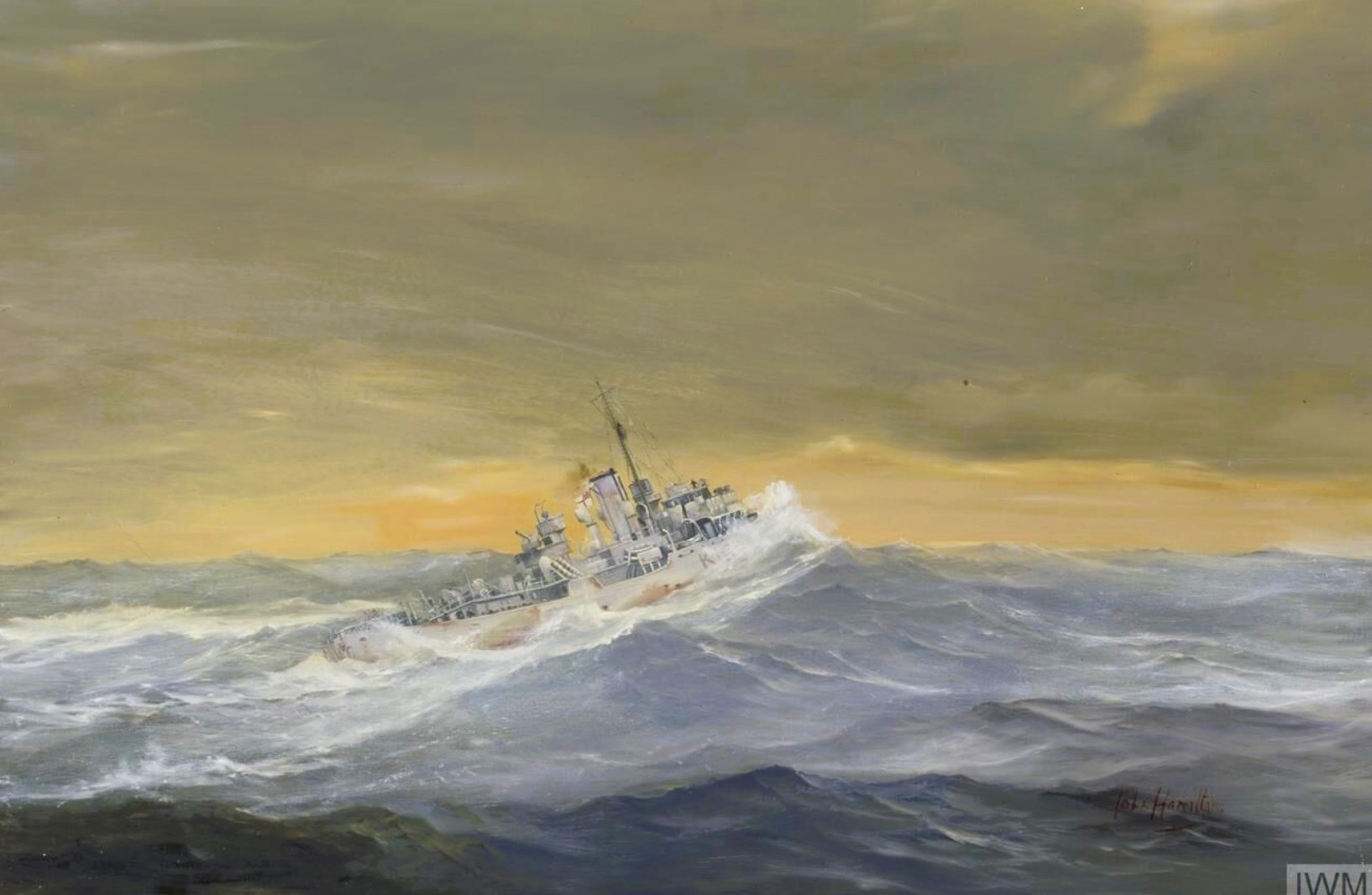
The corvette HMCS Snowberry making way in a heavy sea by John Hamilton. She is shown starboard side on. IWM ART LD 7400
Another is from a Canadian artist.

Snowberry Painted by Fread Thearle in 1988 Beaverbrook Collection of War Art. “Thearle’s painting depicts her crashing through heavy seas. Wind and weather constantly challenged Canada’s navy in its wartime roles during the Second World War. Large numbers of corvettes were produced during the war and used as convoy escorts. Their simple design made it possible to build them quickly in smaller shipyards, like the one at Lauzon, Québec, where the Snowberry was launched in 1940.” CWM 20060128-003
The German scale model company Revell in 2015 debuted a 1:144 version of Snowberry.
The kit included breathtaking box art by Danijel Frka.
Sadly, neither the Royal Navy nor RCN has seen fit to commission a second Snowberry.
Ships are more than steel
and wood
And heart of burning coal,
For those who sail upon
them know
That some ships have a
soul.
If you liked this column, please consider joining the International Naval Research Organization (INRO), Publishers of Warship International
They are possibly one of the best sources of naval study, images, and fellowship you can find. http://www.warship.org/membership.htm
The International Naval Research Organization is a non-profit corporation dedicated to the encouragement of the study of naval vessels and their histories, principally in the era of iron and steel warships (about 1860 to date). Its purpose is to provide information and a means of contact for those interested in warships.
With more than 50 years of scholarship, Warship International, the written tome of the INRO has published hundreds of articles, most of which are unique in their sweep and subject.
PRINT still has its place. If you LOVE warships you should belong.
I’m a member, so should you be!






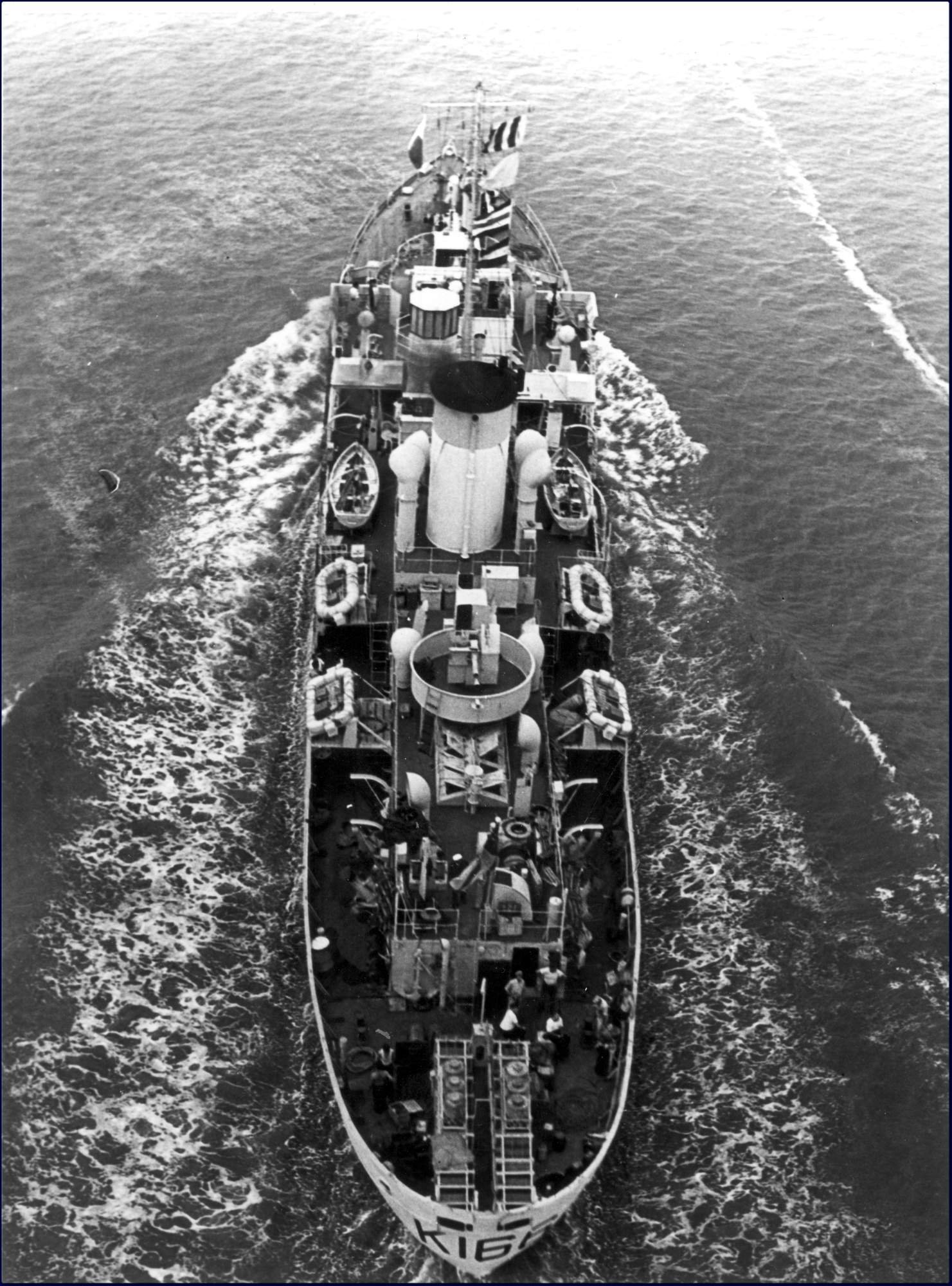





Thank you, Chris!
It’s always a pleasure to “make the acquaintance” of a tin can I didn’t know! I was kinda’ familiar with the Flower-class corvettes, but this article really filled in my sketchy knowledge with some relevant details. “Slight armed,” but better armed for their task–and with a better engineering suite–than the current LCS classes the US Navy is burdened with!
BTW, what is the wood-stocked SMG carried by the two sailors escorting the German POW? Some early Sterling or something?
Thanks again!Bob
Thanks for the kind words, Bob! I agree with you on the LCS 100%. As to the burp gun, it’s a Lanchester, basically an unlicensed copy of the German MP28
Many of the Flower class had their main mast in front of the wheelhouse – must have been a pain for the lookouts. Interestingly most K166 show the main mast abaft the wheelhouse, but the pic just above the paintings has a clearly marked K166 with the main mast in front… go figure
Snowberry was modified as most of the early Flowers. Extended Fcsl , Mast move aft , added AA Guns ,etc. Both pictures are correct for her.